Natural Radioactivity in Soil and Radiological Risk Assessment in Lișava Uranium Mining Sector, Banat Mountains, Romania
Abstract
1. Introduction
2. Materials and Methods
2.1. Study Area and Sampling
2.2. Sample Preparation
2.3. Analytical Techniques
2.4. Radiogical Parameters
2.5. Statistical Analysis and Mapping
3. Results and Discussion
3.1. The Activity Concentrations of Naturally Occurring Radionuclides (238U, 232Th and 40K) in Soil
3.2. Spatial Distribution of 238U, 232Th and 40K in Soil from Lișava Uranium Mining Sector
3.3. Environmental Radiological Risk
3.4. Pearson’s Correlation Analysis
3.5. Mineralogical Futures
4. Conclusions
Author Contributions
Funding
Institutional Review Board Statement
Informed Consent Statement
Data Availability Statement
Acknowledgments
Conflicts of Interest
Appendix A
| Sample ID | 238U | 232Th | 40K | Raeq | DR | Hex | RLI |
| 1 | 54.12 ± 2.7 | 42.23 ± 3,9 | 532.12 ± 51.3 | 155.48 | 72.86 | 109.91 | 0.42 |
| 2 | 48.32 ± 2.3 | 41.34 ± 3.1 | 534.45 ± 51.7 | 148.59 | 69.74 | 105.20 | 0.40 |
| 3 | 103.26 ± 5.7 | 11.32 ± 1.3 | 521.43 ± 50.7 | 159.60 | 76.44 | 115.31 | 0.43 |
| 4 | 216.18 ± 10.1 | 13.32 ± 1.5 | 576.45 ± 52.3 | 279.61 | 132.13 | 199.32 | 0.76 |
| 5 | 32.12 ± 1.7 | 42.32 ± 4.1 | 523.34 ± 52.1 | 132.93 | 62.38 | 94.10 | 0.36 |
| 6 | 53.21 ± 2.4 | 48.16 ± 4.4 | 576.23 ± 52.3 | 166.45 | 77.87 | 117.47 | 0.45 |
| 7 | 75.43 ± 4.6 | 34.21 ± 1.7 | 504.21 ± 51.2 | 163.17 | 76.69 | 115.68 | 0.44 |
| 8 | 197.12 ± 8.1 | 21.11 ± 1.7 | 546.32 ± 52.2 | 269.37 | 126.77 | 191.22 | 0.73 |
| 9 | 213.23 ± 9.8 | 12.32 ± 1.7 | 497.32 ± 50.4 | 269.14 | 126.84 | 191.34 | 0.73 |
| 10 | 312.45 ± 16.1 | 24.21 ± 2.3 | 598.23 ± 54.1 | 393.13 | 184.10 | 277.71 | 1.06 |
| 11 | 396.23 ± 20.3 | 10.12 ± 0.9 | 604.32 ± 50.3 | 457.23 | 214.55 | 323.65 | 1.24 |
| 12 | 311.17 ± 15.6 | 12.34 ± 1.4 | 615.32 ± 52.3 | 376.20 | 177.06 | 267.09 | 1.02 |
| 13 | 256.36 ± 12.8 | 45.32 ± 4.1 | 608.11 ± 50 | 367.99 | 171.35 | 258.48 | 0.99 |
| 14 | 198.34 ± 9.9 | 8.34 ± 0.7 | 600.21 ± 50.1 | 256.48 | 121.88 | 183.85 | 0.69 |
| 15 | 175.13 ± 8.6 | 12.21± 1.5 | 591.21 ± 51.3 | 238.11 | 113.12 | 170.63 | 0.64 |
| 16 | 231.13 ± 11.5 | 9.21 ± 0.9 | 541.78 ± 48.12 | 286.02 | 135.10 | 203.79 | 0.77 |
| 17 | 209.78 ± 10.8 | 23.23 ± 2.4 | 587.21 ± 52.4 | 288.21 | 135.61 | 204.57 | 0.78 |
| 18 | 176.23 ± 8.9 | 11 ± 1.3 | 523.11 ± 50 | 232.24 | 110.03 | 165.98 | 0.63 |
| 19 | 316.32 ± 16.9 | 10.32 ± 1.1 | 534.34 ± 50.5 | 372.22 | 174.82 | 263.70 | 1.01 |
| 20 | 174.32 ± 8.8 | 7.32 ± 0.6 | 504.21± 49.3 | 223.61 | 106.13 | 160.10 | 0.60 |
| 21 | 168.23 ± 8.6 | 11.21 ± 1.3 | 578.03 ±53.3 | 228.77 | 108.77 | 164.08 | 0.62 |
| 22 | 182.29 ± 9.1 | 21.34 ± 2. 1 | 502.34 ± 51.2 | 251.49 | 118.21 | 178.31 | 0.68 |
| 23 | 391.17 ± 19.8 | 17.32 ± 1.7 | 550.34 ± 50.1 | 458.31 | 214.30 | 323.26 | 1.24 |
| 24 | 265.3 ± 13.2 | 11.34 ± 1.5 | 555.23 ± 53.1 | 324.27 | 152.74 | 230.40 | 0.88 |
| 25 | 195.26 ± 9.6 | 12.56 ± 1.9 | 567.32 ± 54.2 | 256.90 | 121.62 | 183.47 | 0.69 |
| 26 | 61.21 ± 3 | 10.67 ± 1.1 | 543.67 ± 51.3 | 118.33 | 57.56 | 86.82 | 0.32 |
| 27 | 63.21 ± 3.2 | 9.34 ± 1.1 | 567.56 ± 54.1 | 120.27 | 58.68 | 88.52 | 0.32 |
| 28 | 105.12 ± 3.9 | 8.45 ± 0.9 | 540.21 ± 51.1 | 158.80 | 76.36 | 115.18 | 0.43 |
| 30 | 111.23 ± 5.6 | 13.23 ± 1.4 | 521.34 ± 50.1 | 170.29 | 81.28 | 122.60 | 0.46 |
| 31 | 134.23 ± 6.8 | 16.34 ± 1.9 | 519.32 ± 52.6 | 197.58 | 93.70 | 141.34 | 0.53 |
| 32 | 98.23 ± 4.9 | 12.32 ± 1.3 | 518.34 ± 50.1 | 155.76 | 74.59 | 112.52 | 0.42 |
| 33 | 126.12 ± 6.43 | 10.23 ± 1.1 | 534.32 ± 48.3 | 181.89 | 86.89 | 131.07 | 0.49 |
| 34 | 218.23 ± 10.1 | 7.23 ± 0.6 | 546.21 ± 51.6 | 270.63 | 128.13 | 193.28 | 0.73 |
| 35 | 265.34 ± 14.2 | 10.34 ± 1.1 | 505.34 ± 50.3 | 319.04 | 150.06 | 226.36 | 0.86 |
| 36 | 165.21 ± 8.3 | 12.23 ± 1.3 | 512.34 ± 52.21 | 222.15 | 105.23 | 158.74 | 0.60 |
| 37 | 156.34 ± 8.1 | 15.23 ± 1.5 | 507.34 ± 50.4 | 217.18 | 102.74 | 154.97 | 0.59 |
| 38 | 309.43 ± 16.3 | 18.23 ± 1.5 | 503.21 ± 51.12 | 374.25 | 175.10 | 264.14 | 1.01 |
| 39 | 291.17 ± 15.1 | 15.23 ± 1.5 | 510.34 ± 51.2 | 352.25 | 165.15 | 249.13 | 0.95 |
| 40 | 307.23 ± 16.2 | 13.34 ± 1.2 | 571.34 ± 54.2 | 370.30 | 173.99 | 262.46 | 1.00 |
| 41 | 302.12 ± 14.9 | 14.21 ± 1.4 | 516.32 ± 51.3 | 362.20 | 169.85 | 256.21 | 0.98 |
| 42 | 315.13 ± 15.9 | 10.37 ± 1. | 517.34 ± 51.2 | 369.79 | 173.58 | 261.84 | 1.00 |
| 43 | 290.23 ± 15 | 11.45 ± 1.5 | 503.32 ± 50.1 | 345.36 | 162.14 | 244.59 | 0.93 |
| 44 | 157.23 ± 7.9 | 10.23 ± 0.9 | 513.45 ± 51.3 | 211.39 | 100.38 | 151.43 | 0.57 |
| 45 | 291.21 ± 15.2 | 8.23 ± 0.7 | 543.21 ± 52.3 | 344.81 | 162.32 | 244.86 | 0.93 |
| 46 | 187.23 ± 9.3 | 8.12 ± 0.7 | 549.32 ± 51.2 | 241.14 | 114.48 | 172.68 | 0.65 |
| 47 | 166.21 ± 8.4 | 9.23 ± 0.8 | 546.45 ± 52.3 | 221.49 | 105.31 | 158.86 | 0.60 |
References
- Belyaeva, O.; Movsisyan, N.; Pyuskyulyan, K.; Sahakyan, L.; Tepanosyan, G.; Saghatelyan, A. Yerevan soil radioactivity: Radiological and geochemical assessment. Chemosphere 2021, 265, 129173. [Google Scholar] [CrossRef] [PubMed]
- Florea, N.; Duliu, O.G. Reahabilitation of the Barzava Uranium Mine Tailings. J. Hazard. Toxic Radioact. Waste 2013, 17, 230–236. [Google Scholar] [CrossRef]
- International Atomic Energy Agency. Evaluating the Reliability of Predictions Made Using Environmental Transfer Models; IAEA: Vienna, Austria, 1989. [Google Scholar]
- Durusoy, A.; Yildirim, M. Determination of radioactivity concentrations in soil samples and dose assessment for Rize Province, Turkey. J. Radiat. Res. Appl. 2013, 10, 348–352. [Google Scholar] [CrossRef]
- Carvalho, F.P.; Oliveira, J.M.; Malta, M. Radioactivity in Soils and Vegetables from Uranium Mining Regions. Procedia Earth Planet. Sci. 2014, 8, 38–42. [Google Scholar] [CrossRef]
- Tye, A.M.; Milodowski, A.E.; Smedley, P.L. Distribution of Natural Radioactivity in the Environment; British Geological Survey Internal Report; British Geological Survey: Nottingham, UK, 2017; p. 45. [Google Scholar]
- Ntsohi, L.; Usman, I.; Mavunda, R.; Kureba, O. Characterization of uranium in soil samples from a prospective uranium mining in Serule, Botswana for nuclear forensic application. J. Radiat. Res. Appl. Sci. 2021, 14, 23–33. [Google Scholar] [CrossRef]
- Ratnikov, A.N.; Sviridenko, D.G.; Popova, G.I.; Sanzharova, N.I.; Mikailova, R.A. The Behaviour of Uranium in Soils and the Mechanisms of Its Accumulation by Agricultural Plants. In Uranium in Plants and the Environment. Radionuclides and Heavy Metals in the Environment; Gupta, D., Walther, C., Eds.; Springer: Cham, Switzerland, 2020. [Google Scholar]
- Rudnick, R.L.; Gao, S. The Composition of the Continental Crust. In The Crust: Treatise on Geochemistry; Holland, H.D., Turekian, K.K., Eds.; Elsevier-Pergamon: Oxford, UK, 2003; Volume 3, pp. 1–64. [Google Scholar]
- International Atomic Energy Agency. Guidelines for Radioelement Mapping Using Gamma Ray Spectrometry Data; IAEA-TECDOC-1363; International Atomic Energy Agency: Vienna, Austria, 2003; p. 173. [Google Scholar]
- Dongarra, G. Geochemical behaviour of uranium in the supergene environment. In Uranium Geochemistry, Mineralogy, Geology, Exploration and Resources; De Vito, B., Ippolito, F., Capaldi, G., Eds.; The Institution of Mining and Metallurgy: London, UK, 1984; p. 18. [Google Scholar]
- Ali, M.A.; Abdel Gawad, A.E.; Ghoneim, M.M. Geology and Mineral Chemistry of Uranium and Thorium-bearing Minerals in Rare-Metal (NYF) Pegmatites of Um Solimate, South Eastern Desert, Egypt. Acta Geol. Sin. 2021, 95, 1568–1582. [Google Scholar] [CrossRef]
- Lasheen, E.S.R.; Zakaly, H.M.H.; Alotaibi, B.M.; Saadawi, D.A.; Ene, A.; Fathy, D.; Awad, H.A.; El Attar, R.M. Radiological Risk Parameters of the Phosphorite Deposits, Gebel Qulu El Sabaya: Natural Radioactivity and Geochemical Characteristics. Minerals 2022, 12, 1385. [Google Scholar] [CrossRef]
- International Atomic Energy Agency. Planning for environmental restoration of uranium mining and milling sites in central and eastern Europe. In Proceedings of the Workshop Held under the Technical Co-Operation Project RER/9/022 on Environmental Restoration in Central and Eastern Europe, Felix, Romania, 4–8 November 1996; No. IAEA-TECDOC-982. International Atomic Energy Agency: Vienna, Austria, 1997. [Google Scholar]
- European Commission, Directorate-General for Energy. Verification under the terms of Article 35 of the Euratom Treaty. Technical Report; In Uranium Mining, Processing, Fuel Fabrication and National Monitoring Networks, Romania; Ro-12/05; European Commission, Directorate-General for Energy (ENER): Brussels, Belgium, 2012; p. 64. [Google Scholar]
- Brandula, O.; Lazăr, M.; Faur, F. Ecological Reconstruction of Radioactive Mining Waste Dumps—Case Study of Natra Waste Dump. Res. J. Agric. Sci. 2015, 47, 19–29. [Google Scholar]
- National Uranium Company. Review of the Technical Project Regarding the Execution of Closure and Rehabilitation Works of Lişava Mine; National Uranium Company (NUC): Caraș Severin, Romania, 2010. (In Romanian) [Google Scholar]
- Gheuca, I.; Ilinca, V. Geological Map of Romania, 1:200,000 Scale; Geological Institute of Romania: Bucharest, Romania, 2022. [Google Scholar]
- Dahlkamp, F.J. Uranium Deposits of the World: Europe; Springer: Berlin/Heidelberg, Germany, 2016; p. 792. [Google Scholar]
- Bejenaru, C.; Cioloboc, D. Uranium Exploration and Production in Romania: Case Histories and Prospects. Recent Developments in Uranium Resources and Supply; No. IAEA-TECDOC-823; IAEA: Vienna, Austria, 1993; pp. 193–205. [Google Scholar]
- Nitu, G. Les conditions tectonomagmatiques de la formation des agistments d’uranium de Roumanie. In Formation of Uranium Ore Deposits; International Atomic Energy Agency (IAEA): Vienna, Austria, 1974; pp. 679–692. [Google Scholar]
- Salminen, R.; Batista, M.J.; Bidovec, M.; Demetriades, A.; De Vivo, B.; De Vos, W.; Duris, M.; Gilucis, A.; Gregorauskiene, V.; Halamić, J.; et al. Geochemical Atlas of Europe, Part 1, Background Information, Methodology and Maps; Geological Survey of Finland: Espoo, Filand, 2005; p. 526. [Google Scholar]
- Yang, J.; Sun, Y. Natural radioactivity, and dose assessment in surface soil from Guangdong, a high background radiation province in China. J. Radiat. Res. Appl. Sci. 2022, 15, 145–151. [Google Scholar] [CrossRef]
- Sandu, M.C.; Iancu, O.G.; Chelariu, C.; Ion, A.; Balaban, S.I.; Scarlat, A.A. Radiological risk assessment and spatial distribution of naturally occurring radionuclides within riverbed sediments near uranium deposits: Tulgheș-Grințieș, Eastern Carpathians (Romania). J. Radiat. Res. Appl. 2020, 13, 730–746. [Google Scholar] [CrossRef]
- Ion, A. Assessment of natural radioactivity level in rocks of Ditrau Alkaline Massif area, Eastern Carpathians, Romania. In Proceedings of the 12th International Multidisciplinary Scientific GeoConference SGEM 2012, Albena, Bulgaria, 17–23 June 2012; Volume 5, pp. 87–94. [Google Scholar]
- Dincă, G.; Apopei, A.I.; Szabo, R.; Maftei, A.E. The Effect of Mn Substitution on Natural Sphalerites by Means of Raman Spectroscopy: A Case Study of the Săcărâmb Au-Ag-Te Ore Deposit, Apuseni Mountains, Romania. Minerals 2022, 12, 885. [Google Scholar] [CrossRef]
- Beretka, J.; Mathew, P.J. Natural radioactivity of Australian building materials, industrial wastes and by-products. Health Phys. 1985, 48, 87–95. [Google Scholar] [CrossRef] [PubMed]
- United Nations Scientific Committee on the Effects of Atomic Radiation. Sources and Effect of Ionizing Radiation; Report to the General Assembly, with Scientific Annexes; United Nations Scientific Committee on the Effects of Atomic Radiation (UNSCEAR): New York, NY, USA, 2000. [Google Scholar]
- Ramasamy, V.; Suresh, G.; Meenakshisundaram, V.; Gajendran, V. Evaluation of Natural Radionuclide Content in River Sediments and Excess Lifetime Cancer Risk Due to Gamma Radioactivity. Res. J. Environ. Earth Sci. 2009, 1, 6–10. [Google Scholar]
- Ravisankar, R.; Chandramohan, J.; Chandrasekaran, A.; Jebakumar, J.P.P.; Vijayalakshmi, I.; Vijayagopal, P.; Venkatraman, B. Assessments of radioactivity concentration of natural radionuclides and radiological hazard indices in sediment samples from the East coast of Tamilnadu, India with statistical approach. Mar. Pollut. Bull. 2015, 97, 419–430. [Google Scholar] [CrossRef] [PubMed]
- Amin, R.M. Gamma radiation measurements of naturally occurring radioactive sample from commercial Egyptian granites. Environ. Earth Sci. 2012, 67, 771–775. [Google Scholar] [CrossRef]
- Petrescu, L.; Bilal, E.; Iatan, L.E. The impact of a uranium mining site on the stream sediments (Crucea mine, Romania). Sci. Ann. Sch. Geol. 2011, 100, 121–126. [Google Scholar]
- Nikolov, J.; Forkapić, S.; Hansman, J.; Bikit, I.; Vesković, M.; Todorović, N.; Mrđa, D.; Bikit, K. Natural radioactivity around former uranium mine, Gabrovnica in Eastern Serbia. J. Radioanal. Nucl. Chem. 2014, 302, 477–482. [Google Scholar] [CrossRef]
- Akpanowo, M.; Umaru, I.; Iyakwari, S.; Joshua, E.O.; Yusuf, S.; Ekong, G.B. Determination of natural radioactivity levels and radiological hazards in environmental samples from artisanal mining sites of Anka, North-West Nigeria. Sci. Afr. 2020, 10, e05561. [Google Scholar] [CrossRef]
- Abedin, M.; Karim, M.; Khandaker, M.U.; Kamal, M.; Hossain, S.; Miah, M.; Bradley, D.; Faruque, M.; Sayyed, M. Dispersion of radionuclides from coal-fired brick kilns and concomitant impact on human health and the environment. Radiat. Phys. Chem. 2020, 177, 109165. [Google Scholar] [CrossRef]
- Caridi, F.; Di Bella, M.; Sabatino, G.; Belmusto, G.; Fede, M.R.; Romano, D.; Italiano, F.; Mottese, A.F. Assessment of Natural Radioactivity and Radiological Risks in River Sediments from Calabria (Southern Italy). Appl. Sci. 2021, 11, 1729. [Google Scholar] [CrossRef]
- Antunes, M.; Santos, A.; Valente, T.; Albuquerque, T. Spatial Mobility of U and Th in a U-enriched Area (Central Portugal). Appl. Sci. 2020, 10, 7866. [Google Scholar] [CrossRef]
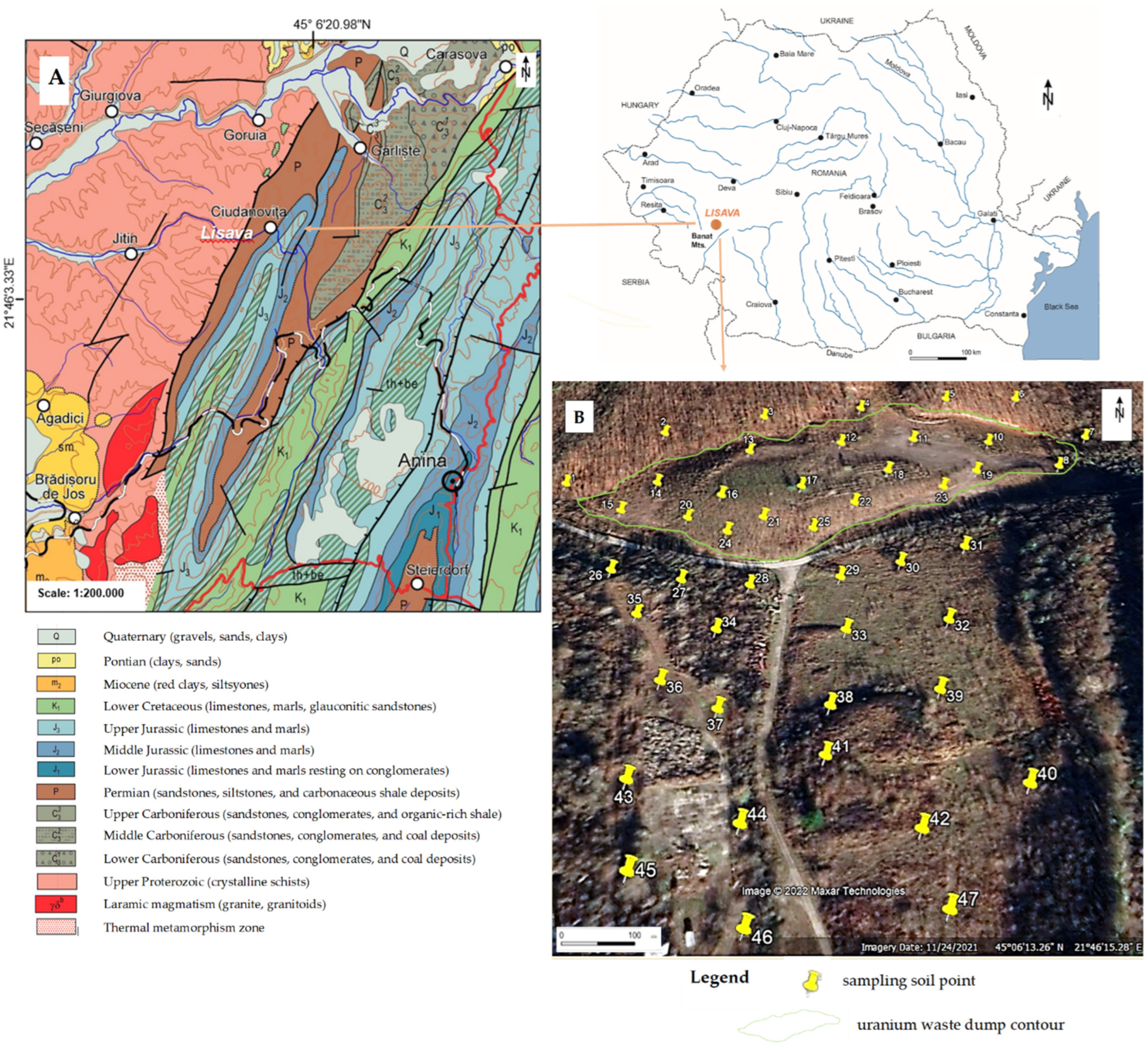
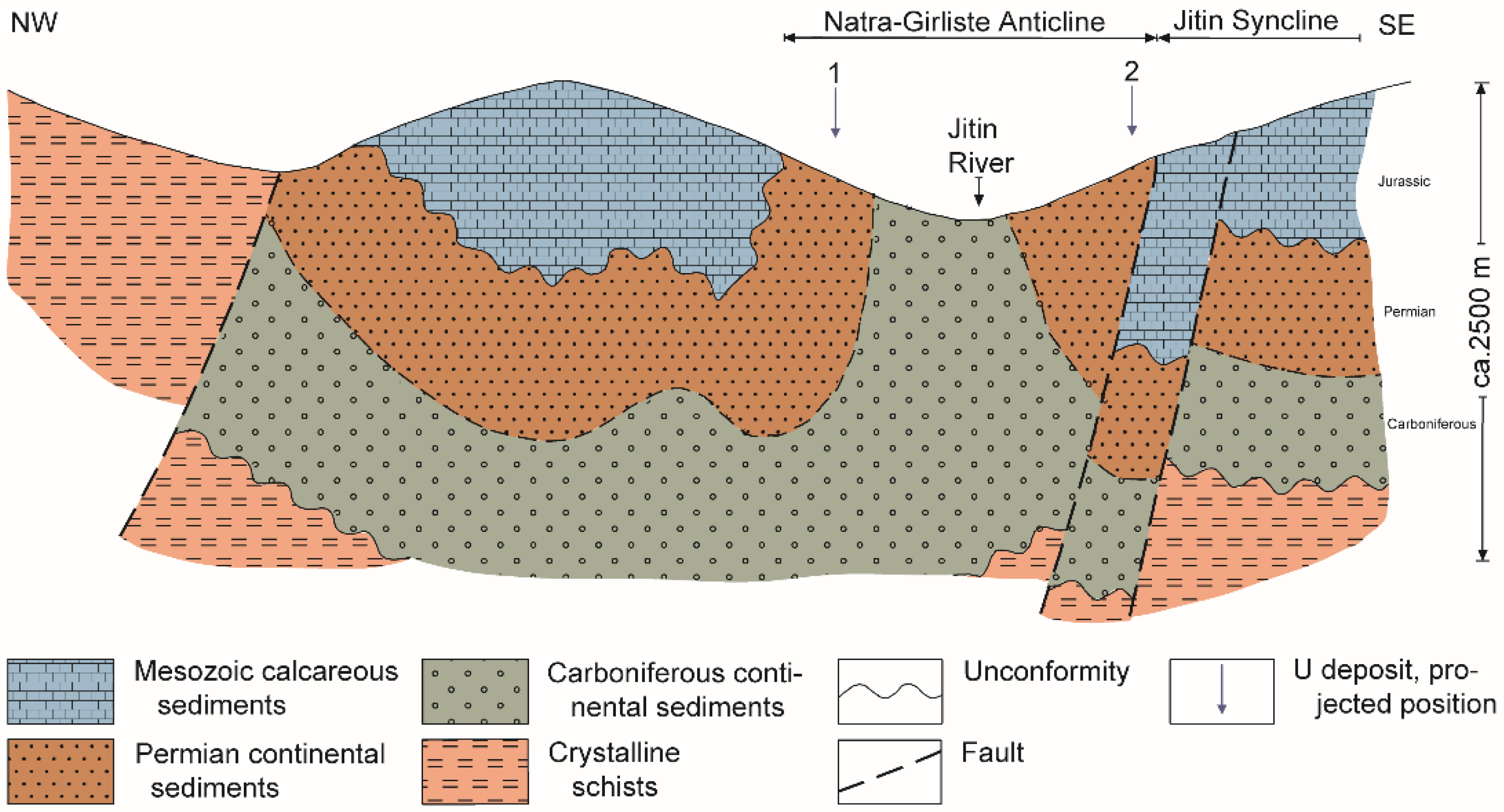

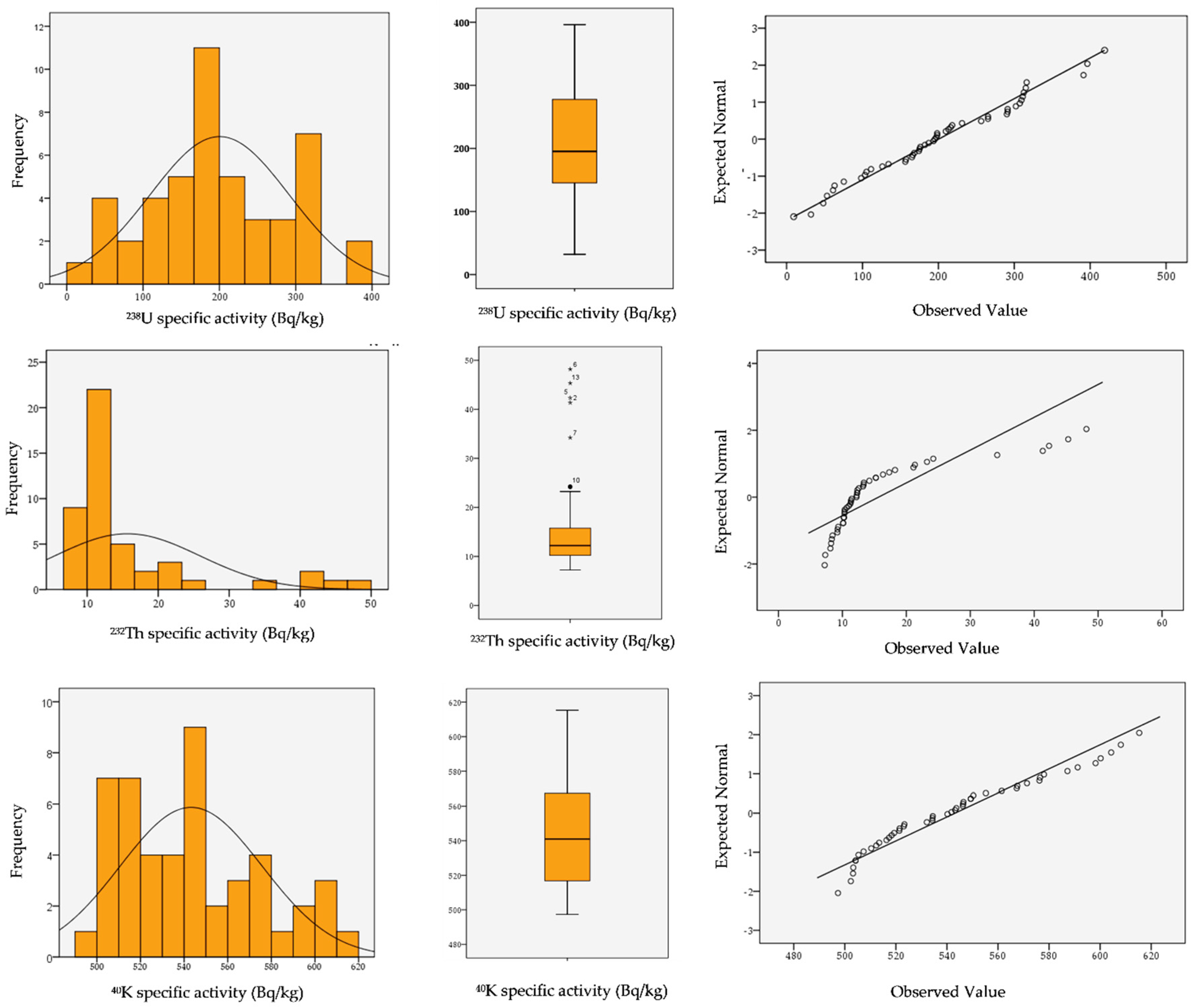
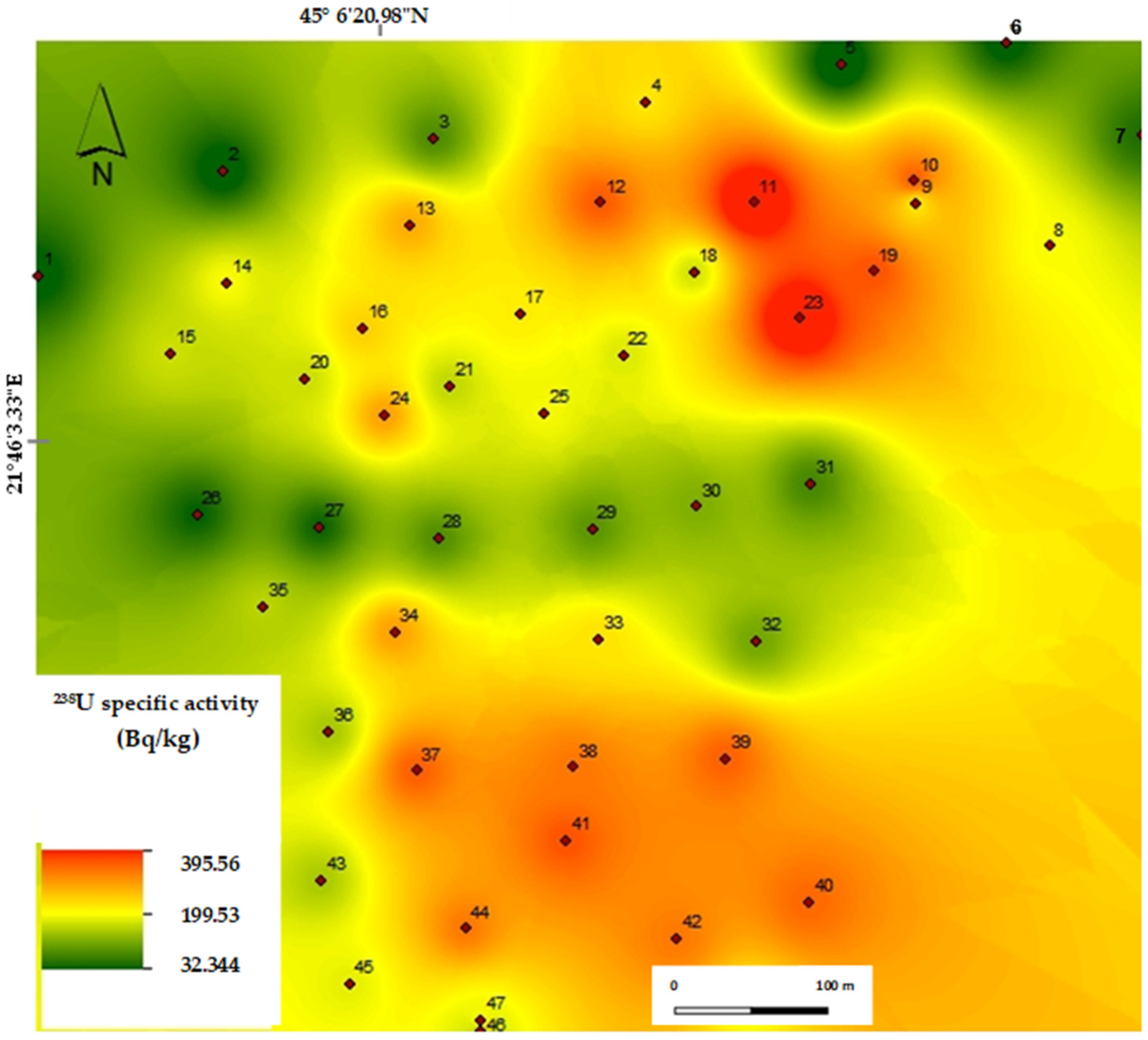

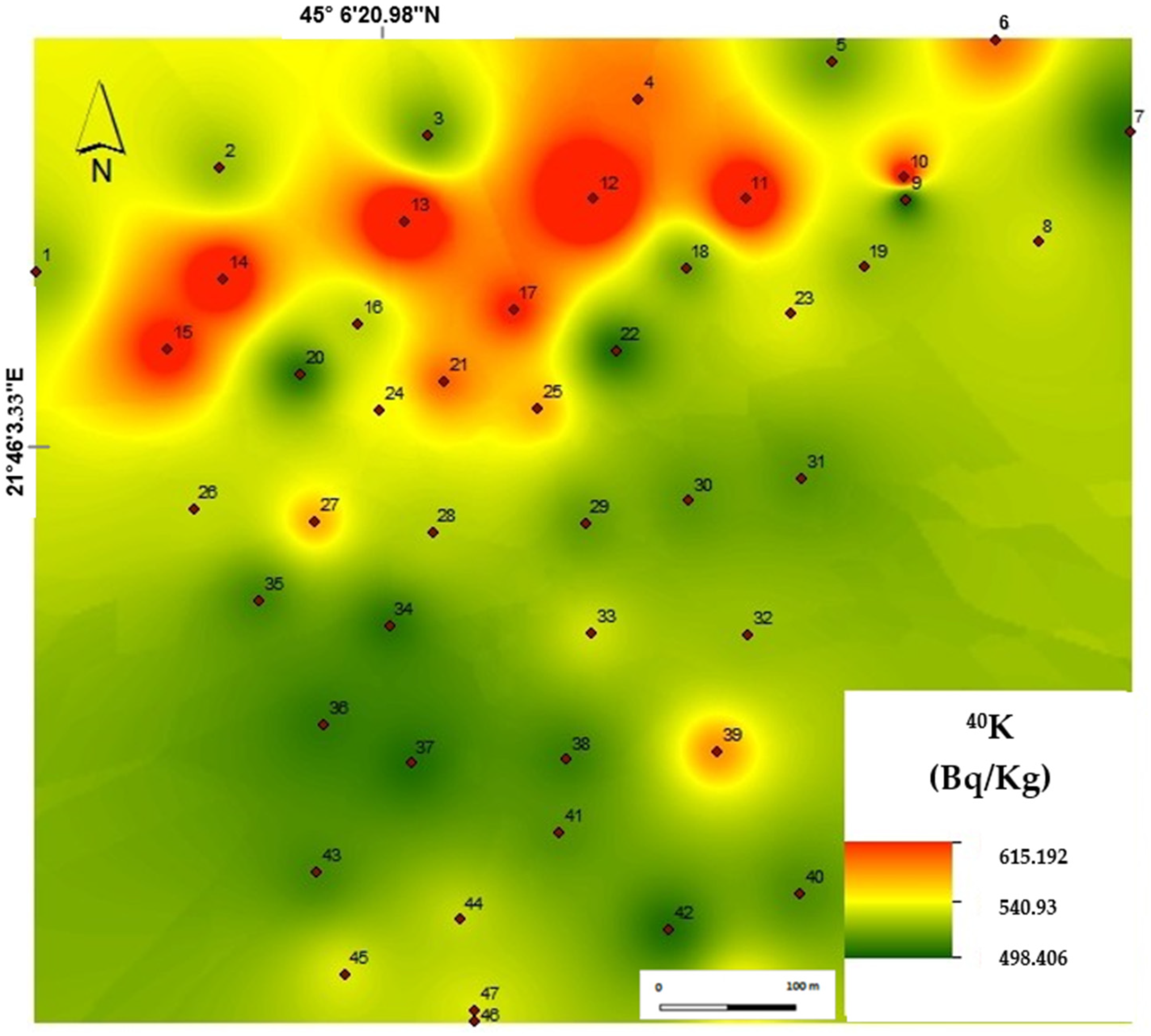



| Radiological Parameter | Equation | References |
|---|---|---|
| RRadium equivalent activity (Raeq) | Raeq = AU + 1.43ATh + 0.077AK (Bq/kg) | [27,28] |
| Absorbed gamma dose rate (DR) | DR = 0.462AU + 0.604ATh + 0.042AK (nGy/h) | [28,29] |
| External hazard index (Hex) | Hex = (AU/370) + (ATh/259) + (AK/4810) | [27,30] |
| Representative level index (RLI) | RLI = (1/150AU) + (1/100ATh) + (1/1500AK) | [30,31] |
| N | 238U (Bq/kg) | 232Th (Bq/kg) | 40K (Bq/kg) | Raeq (Bq/kg) | DR (nGy/h) | Hex | RLI | |
|---|---|---|---|---|---|---|---|---|
| Minimum | 47 | 32.120 | 7.230 | 497.320 | 118.331 | 57.558 | 0.320 | 0.877 |
| Maximum | 47 | 396.230 | 48.160 | 615.320 | 458.314 | 214.552 | 1.239 | 3.148 |
| Mean | 47 | 197.213 | 16.215 | 543.213 | 262.228 | 123.721 | 0.708 | 1.839 |
| Std. Deviation | 47 | 92.491 | 10.785 | 32.622 | 88.915 | 41.254 | 0.240 | 0.586 |
| Skewness | 47 | 0.119 | 1.913 | 0.569 | 0.329 | 0.318 | 0.329 | 0.343 |
| Kurtosis | 47 | −0.639 | 2.595 | −0.665 | −0.700 | −0.700 | −0.700 | −0.641 |
| Country | 238U (Bq/kg) | 232Th (Bq/kg) | 40K (Bq/kg) | References |
|---|---|---|---|---|
| This study | 197.21 | 16.21 | 543.21 | - |
| Romania (Crucea) | 559.7 | 91.52 | - | [32] |
| Serbia (Gabrovnica) | 249 | 69 | 960 | [33] |
| China | 79.3 | 101.0 | 535.8 | [23] |
| Armenia | 45.69 | 37.25 | 294.35 | [1] |
| Nigeria | 63.29 | 226.67 | 832.59 | [34] |
| Egypt | 137 | 82 | 1082 | [31] |
| Median concentration values | 35 | 30 | 400 | [28] |
| 238U | 232Th | 40K | Raeq | DR | Hex | RLI | |
|---|---|---|---|---|---|---|---|
| 238U | 1 | ||||||
| 232Th | −0.350 | 1 | |||||
| 40K | 0.215 | 0.091 | 1 | ||||
| Raeq | 0.986 | −0.189 | 0.268 | 1 | |||
| DR | 0.119 | −0.202 | 0.270 | 1.000 | 1 | ||
| Hex | 0.986 | −0.189 | 0.267 | 1.000 | 1.000 | 1 | |
| RLI | 0.567 | −0.157 | 0.193 | 0.563 | 0.564 | 0.563 | 1 |
Publisher’s Note: MDPI stays neutral with regard to jurisdictional claims in published maps and institutional affiliations. |
© 2022 by the authors. Licensee MDPI, Basel, Switzerland. This article is an open access article distributed under the terms and conditions of the Creative Commons Attribution (CC BY) license (https://creativecommons.org/licenses/by/4.0/).
Share and Cite
Ion, A.; Cosac, A.; Ene, V.V. Natural Radioactivity in Soil and Radiological Risk Assessment in Lișava Uranium Mining Sector, Banat Mountains, Romania. Appl. Sci. 2022, 12, 12363. https://doi.org/10.3390/app122312363
Ion A, Cosac A, Ene VV. Natural Radioactivity in Soil and Radiological Risk Assessment in Lișava Uranium Mining Sector, Banat Mountains, Romania. Applied Sciences. 2022; 12(23):12363. https://doi.org/10.3390/app122312363
Chicago/Turabian StyleIon, Adriana, Ana Cosac, and Vlad Victor Ene. 2022. "Natural Radioactivity in Soil and Radiological Risk Assessment in Lișava Uranium Mining Sector, Banat Mountains, Romania" Applied Sciences 12, no. 23: 12363. https://doi.org/10.3390/app122312363
APA StyleIon, A., Cosac, A., & Ene, V. V. (2022). Natural Radioactivity in Soil and Radiological Risk Assessment in Lișava Uranium Mining Sector, Banat Mountains, Romania. Applied Sciences, 12(23), 12363. https://doi.org/10.3390/app122312363





